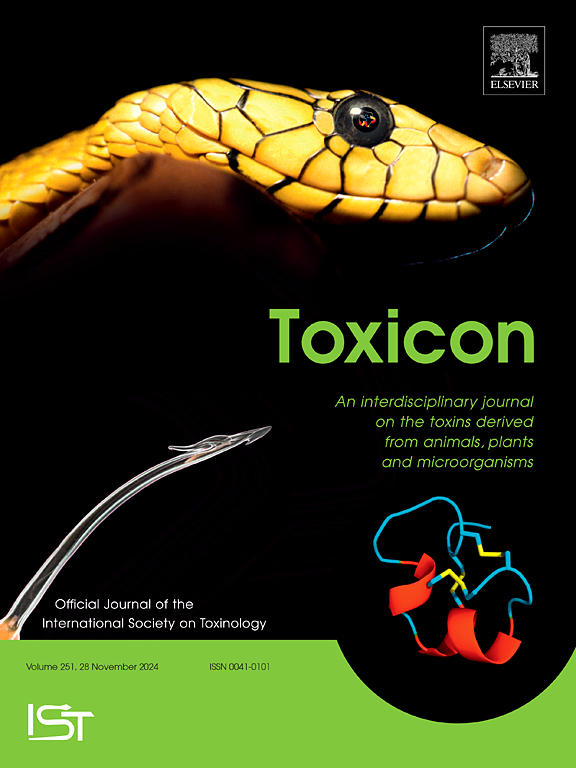Botulinum neurotoxin type DC (BoNT/DC) cleavage of VAMP3 reduces melanin production in melanocytes
IF 2.6
4区 医学
Q2 PHARMACOLOGY & PHARMACY
引用次数: 0
Abstract
Melanin in skin and hair protects cells from UV damage; however, uneven skin color or hyperpigmentation is a common aesthetic concern. Melanin is synthesized in melanosomes, organelles within melanocytes, where tyrosinase converts tyrosine to melanin. Trafficking of tyrosinase or other cargo (eg, premelanosome protein [PMEL]) may depend on vesicle-associated membrane proteins (VAMPs); interfering with VAMPs has been reported to impact melanogenesis. Botulinum neurotoxin type DC (BoNT/DC) is a naturally occurring mosaic serotype that cleaves the SNARE proteins VAMP1-3. This study evaluated BoNT/DC as a potential treatment for hyperpigmentation by testing if it affects melanogenesis. In melanocytes, BoNT/DC cleaved VAMP2 and VAMP3, and knockdown of VAMP3, but not VAMP2, reduced melanin content, which suggests that BoNT/DC may affect melanogenesis via VAMP3 cleavage. Indeed, BoNT/DC (5 nM) produced a ∼50 % reduction in melanin content in melanocytes, and in 2 human melanocyte models, BoNT/DC, but not BoNT/A, significantly reduced melanin content (∼40–50 %) without cytotoxicity. Electron microscopy showed that BoNT/DC-treated melanocytes contained more early-stage (II) and fewer late-stage (IV) melanosomes than vehicle- or BoNT/A-treated melanocytes. Overall, BoNT/DC reduced melanin content in multiple melanocyte models, and its lightening effects are likely due to VAMP3 cleavage interfering with trafficking of cargo (eg, tyrosinase, PMEL) required for melanogenesis.

肉毒杆菌神经毒素型DC (BoNT/DC)切割VAMP3可减少黑色素细胞中黑色素的产生
皮肤和头发中的黑色素可以保护细胞免受紫外线的伤害;然而,不均匀的肤色或色素沉着是一个常见的审美问题。黑色素是在黑素小体中合成的,黑素小体是黑素细胞内的细胞器,酪氨酸酶将酪氨酸转化为黑色素。酪氨酸酶或其他货物(如黑素体前蛋白[PMEL])的运输可能依赖于囊泡相关膜蛋白(VAMPs);据报道,干扰VAMPs会影响黑色素生成。肉毒杆菌神经毒素型DC (BoNT/DC)是一种自然发生的马赛克血清型,可切割SNARE蛋白VAMP1-3。本研究通过测试BoNT/DC是否影响黑色素生成来评估BoNT/DC作为色素沉着症的潜在治疗方法。在黑色素细胞中,BoNT/DC可切割VAMP2和VAMP3,而VAMP3的敲低可降低黑色素含量,这表明BoNT/DC可能通过切割VAMP3影响黑色素的形成。事实上,BoNT/DC (5 nM)使黑素细胞中的黑色素含量降低了~ 50%,并且在2个人类黑素细胞模型中,BoNT/DC(而不是BoNT/ a)显著降低了黑色素含量(~ 40 - 50%),而没有细胞毒性。电镜显示,BoNT/ dc处理的黑素细胞比对照或BoNT/ a处理的黑素细胞含有更多的早期(II)和更少的晚期(IV)黑素体。总体而言,BoNT/DC降低了多种黑素细胞模型中的黑色素含量,其美白效果可能是由于VAMP3的切割干扰了黑色素生成所需的货物运输(例如酪氨酸酶,PMEL)。
本文章由计算机程序翻译,如有差异,请以英文原文为准。
求助全文
约1分钟内获得全文
求助全文
来源期刊

Toxicon
医学-毒理学
CiteScore
4.80
自引率
10.70%
发文量
358
审稿时长
68 days
期刊介绍:
Toxicon has an open access mirror Toxicon: X, sharing the same aims and scope, editorial team, submission system and rigorous peer review. An introductory offer Toxicon: X - full waiver of the Open Access fee.
Toxicon''s "aims and scope" are to publish:
-articles containing the results of original research on problems related to toxins derived from animals, plants and microorganisms
-papers on novel findings related to the chemical, pharmacological, toxicological, and immunological properties of natural toxins
-molecular biological studies of toxins and other genes from poisonous and venomous organisms that advance understanding of the role or function of toxins
-clinical observations on poisoning and envenoming where a new therapeutic principle has been proposed or a decidedly superior clinical result has been obtained.
-material on the use of toxins as tools in studying biological processes and material on subjects related to venom and antivenom problems.
-articles on the translational application of toxins, for example as drugs and insecticides
-epidemiological studies on envenoming or poisoning, so long as they highlight a previously unrecognised medical problem or provide insight into the prevention or medical treatment of envenoming or poisoning. Retrospective surveys of hospital records, especially those lacking species identification, will not be considered for publication. Properly designed prospective community-based surveys are strongly encouraged.
-articles describing well-known activities of venoms, such as antibacterial, anticancer, and analgesic activities of arachnid venoms, without any attempt to define the mechanism of action or purify the active component, will not be considered for publication in Toxicon.
-review articles on problems related to toxinology.
To encourage the exchange of ideas, sections of the journal may be devoted to Short Communications, Letters to the Editor and activities of the affiliated societies.
 求助内容:
求助内容: 应助结果提醒方式:
应助结果提醒方式:


